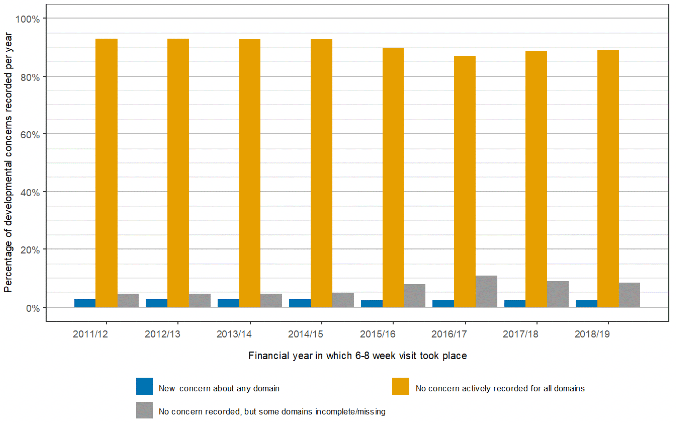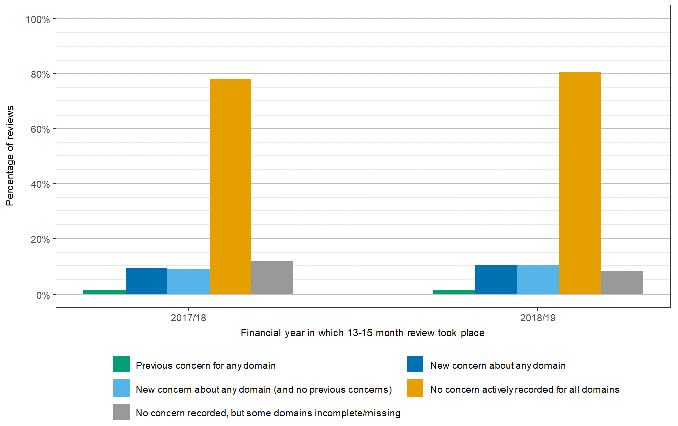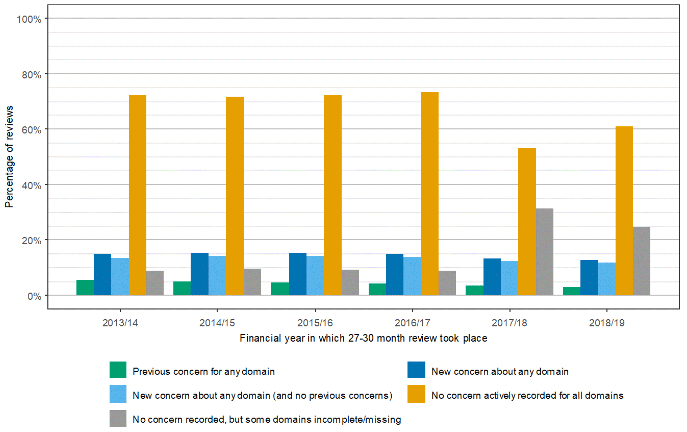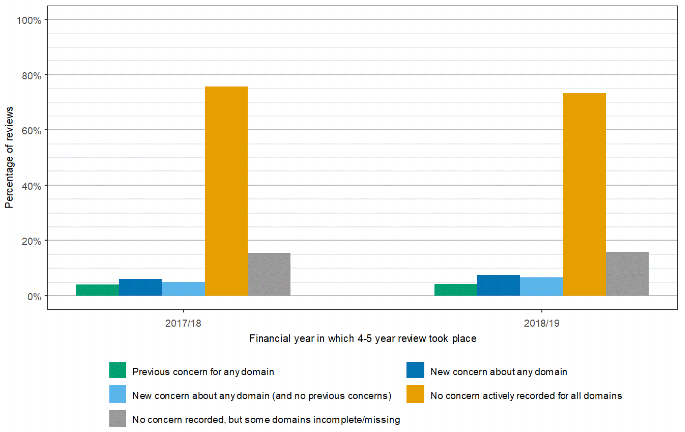Universal Health Visiting Pathway evaluation: phase 1 report - routine data analysis - implementation and delivery
The Universal Health Visiting Pathway was introduced in Scotland in 2015 to refocus the approach to health visiting in Scotland. This is the final report of four that provides findings about the implementation and delivery of the pathway as part of the national evaluation of Health Visiting.
Developmental concerns
Assessment of children's development forms a core part of all child health reviews. Review records capture the outcome of developmental assessments for a set of domains (e.g. social, emotional, behavioural development – for the full set of domains see Table 6). When the 27-30 month review was introduced in April 2013 there were nine domains being assessed (Table 6). From April 2017, the number of domains has reduced to eight, with some domains being merged, and a new domain added (Problem Solving). The health visitor can record for each domain whether there were no concerns (N), a concern that was newly suspected as a result of the assessment carried out during the current review (from 13-15 months onwards) (C), a concern or disorder that was known prior to the review and is on-going at the time of the following review (P), or if the assessment was incomplete (X).[8]
6-8 week visit
No developmental concerns are recorded at the first visit in line with guidance. Therefore no previous developmental concerns can be reported at the 6-8 week visit. The percentage of reviews in which a practitioner has recorded that there is a developmental concern at 6-8 weeks is about 2.5% per year over the eight years (see Figure 36); the percentage with no concern actively recorded for all domains varies from a maximum value of 93.0% in 2012/13 to a minimum of 86.9% in 2016/17.
13-15 month review
There are only two years for which review data are available, since the review started in April 2017. Developmental concerns had previously been identified in a very small number of children (1.3% of those with reviews) (see Figure 37). This would have been a concern noted at the 6-8 week review. About 10% of reviews recorded children who were identified as having a new developmental concern reported for the first time at this review; a very small percentage (0.2%) of these children had been recorded previously with a concern in a different domain (see Table 6 for domains). In almost 80% of reviews, children were actively recorded as having no developmental concerns (i.e. information was complete for all domains).
27-30 month review
Over the six years for which data are available for this review, the percentage of reviews in which a previous developmental concern has been recorded appears to decline slightly, from 5.4% in 2013/14 to 2.8% in 2018/19 (Figure 38). It should be noted that this is likely to be lower than the level of new concerns recorded at the previous review, because some of these concerns will have been resolved in between reviews and then recorded as 'no concern' going into the 27-30 month review. For the first four years, the percentage with a new developmental concern identified is constant at about 15%: this decreases to 13.2% in 2017/18 and 12.7% in 2018/19. In all years, in approximately 1% of reviews a new concern has been recorded for a child who had previously been identified with a developmental concern in a different domain.
The percentage of reviews in which no concern is actively recorded and no domains have missing data is approximately 72% for the first four years; this value then declines to 53.2% in 2017/18, and then increases to 60.8% in the final year. However, the percentage of reviews where no concern is actively recorded, but some domains are missing increases substantially in these final two years. This coincides with the introduction of the ASQ as the mandatory assessment tool, and changes to the domains that were captured in the CHSP is at least partly related to NHS Greater Glasgow & Clyde using the SDQ/SSLM, which does not contain data for the problem solving domain and thus appears incomplete in the records. Thus the decrease in no developmental concerns being identified is due to the review not being recorded completely and changes to the assessment tools and recording of domains, rather than an increase in developmental concerns.
4-5 year review
Again, data are only available for two 4-5 year reviews. A previous developmental concern has been recorded in about 4% of reviews (see Figure 39). As noted in the previous section, a concern recorded at 27-30 months may have resolved prior to the 4-5 year review, and thus appear as 'no concern' at the start of the 4-5 year review. For example, at the 13-15 month review, a child may have no developmental concerns and thus the health visitor will have recorded 'no concerns'. By the time of the 27-30 month review, the child may have a concern regarding speech, and therefore 'new concern' in the speech, language and communication domain will be recorded in this review. However, by the time of the 4-5 year review, the child's speech is developing fine, so the child will have 'no concern' recorded.
A new concern has been recorded in 5.9% of reviews provided in 2017/18 and 7.4% in 2018/19; again, in about 0.9% of reviews, a child with a new concern has also been previously identified with a developmental concern in a different domain. In about 74% of reviews no concern has been actively recorded for all domains; in 15% of reviews no concern has been identified, but recording is not complete for all domains.
| Reviews recorded using April 2013 – March 2017 CHSP-PS form | Reviews recorded using April 2017 CHSP-PS form |
|---|---|
| Social | Personal/Social |
| Emotional | Emotional/Behavioural |
| Behavioural | |
| Attention | |
| Speech, Language & Communication | Speech, Language & Communication |
| Fine Motor | Fine Motor |
| Gross Motor | Gross Motor |
| Vision | Vision |
| Hearing | Hearing |
| n/a | Problem solving |
Notes
For each domain, the health visitor recorded one of the following responses:
- N no concerns
- C concern newly suspected
- P concern/disorder previously identified
- X assessment incomplete
In some reviews, no concern has been recorded, but not all the developmental domains have been completed or information is missing; this situation is included separately in Figure 38-41.




Notes to Figures 36-39
1. See Table 1 above for the number of reviews delivered in each financial year. If fewer than 1,000 reviews were delivered in a financial year, data for that year have not been analysed (e.g. for the 13-15 month review, 125 were conducted in 2016/17; for the 27-30 month review, 296 were provided in 2012/13; and for the 4-5 year review, 19 were provided in 2016/17).
Source for Figures 36-39
The source for all child health data is CHSP-PreSchool May 2020, Public Health Scotland. The source for births data is NRS.
Contact
Email: justine.menzies@gov.scot
There is a problem
Thanks for your feedback